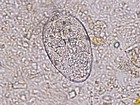Difference between revisions of "Paramphistomum"
Jump to navigation
Jump to search
| (8 intermediate revisions by 2 users not shown) | |||
| Line 1: | Line 1: | ||
| − | {{ | + | {{review}} |
{{Taxobox | {{Taxobox | ||
|name = Paramphistomum | |name = Paramphistomum | ||
| Line 6: | Line 6: | ||
|class = [[:Category:Trematodes|Trematoda]] | |class = [[:Category:Trematodes|Trematoda]] | ||
|sub-class = Digenea | |sub-class = Digenea | ||
| − | |order = | + | |order = |
| + | |||
| + | |sub-order = | ||
|super-family = | |super-family = | ||
|family = Paramphistomatidae | |family = Paramphistomatidae | ||
| Line 13: | Line 15: | ||
|species = | |species = | ||
}} | }} | ||
| − | |||
[[Image:Paramphistomum cervi.jpg|right|150px|thumb|''Paramphistomum cervi'' - Joaquim Castellà Veterinary Parasitology Universitat Autònoma de Barcelona]] | [[Image:Paramphistomum cervi.jpg|right|150px|thumb|''Paramphistomum cervi'' - Joaquim Castellà Veterinary Parasitology Universitat Autònoma de Barcelona]] | ||
| − | |||
| − | The adult fluke is plump and cylindrical (unusual for a [[Trematodes|trematode]]). It attaches to the wall of the rumen without causing serious damage. The eggs are like those of | + | ''Paramphistomum spp'' are of the family ''Notocotylidae''. ''Paramphistomomes'' are rare in the UK, but can cause severe losses in ruminants in the wet tropics |
| + | |||
| + | The adult fluke is plump and cylindrical (unusual for a [[Trematodes|trematode]]). It attaches to the wall of the rumen without causing serious damage. The eggs are like those of ''Fasciola'', but are colourless, and have long filaments present at the poles. | ||
The intermediate hosts are water snails, and these shed '''cercariae''' which later form '''metacercariae''' on vegetation. | The intermediate hosts are water snails, and these shed '''cercariae''' which later form '''metacercariae''' on vegetation. | ||
| Line 23: | Line 25: | ||
Disease occurs if metacercariae are eaten in large numbers. [[Enteritis]] and [[diarrhoea]] result when immature flukes migrate along the small intestine, (where the metacercariae excyst) towards the rumen. | Disease occurs if metacercariae are eaten in large numbers. [[Enteritis]] and [[diarrhoea]] result when immature flukes migrate along the small intestine, (where the metacercariae excyst) towards the rumen. | ||
| − | + | [[Category:Trematodes]] | |
| − | + | [[Category:To_Do_-_Max]] | |
| − | + | [[Category:To_Do_-_Review]] | |
| − | |||
| − | |||
| − | |||
| − | |||
| − | |||
| − | |||
| − | |||
| − | |||
| − | |||
| − | [[Category: | ||
Revision as of 04:59, 4 August 2010
| This article has been peer reviewed but is awaiting expert review. If you would like to help with this, please see more information about expert reviewing. |
| Paramphistomum | |
|---|---|
| Kingdom | Animalia |
| Phylum | Platyhelminthes |
| Class | Trematoda |
| Sub-class | Digenea |
| Family | Paramphistomatidae |
| Genus | Paramphistomum |
Paramphistomum spp are of the family Notocotylidae. Paramphistomomes are rare in the UK, but can cause severe losses in ruminants in the wet tropics
The adult fluke is plump and cylindrical (unusual for a trematode). It attaches to the wall of the rumen without causing serious damage. The eggs are like those of Fasciola, but are colourless, and have long filaments present at the poles.
The intermediate hosts are water snails, and these shed cercariae which later form metacercariae on vegetation.
Disease occurs if metacercariae are eaten in large numbers. Enteritis and diarrhoea result when immature flukes migrate along the small intestine, (where the metacercariae excyst) towards the rumen.
